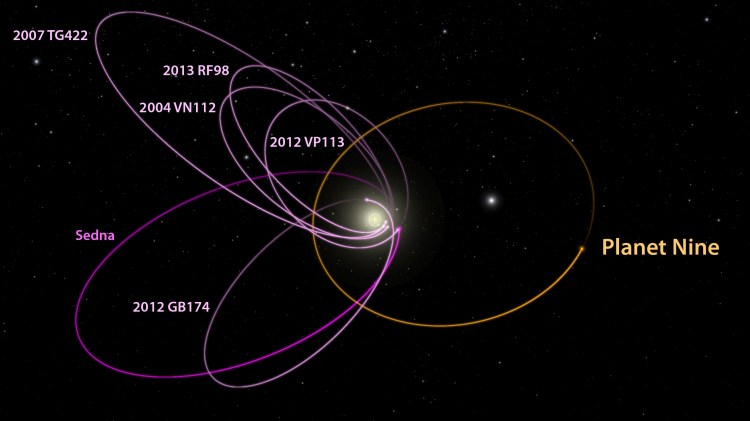Since the controversial demotion of Pluto in 2006 to the status of dwarf planet, there have technically been only eight planets in our solar system. But according to some California Institute of Technology astronomers, it looks like there might be nine after all.
The astronomers this month reported they’ve found very solid evidence of a planet about 10 times the mass of the Earth orbiting far beyond Neptune and Pluto. Neptune circles roughly 30 astronomical units from the sun (one astronomical unit, or AU, is the distance from the sun to the Earth, about 93 million miles) and is about 17 times the mass of the Earth. Pluto, which was deemed by a gathering of International Astronomical Union astronomers to be too small to remain categorized as a planet, is less than 18 percent the mass of the moon and orbits roughly 39 AU from the sun.
This new planet, variously nicknamed Planet Nine, Planet X and Planet Phattie (by the two discoverers, Mike Brown and Konstantin Batygin), has not actually been seen yet because it’s so far away. Its closest approach to the sun, the astronomers say, is probably about 200 astronomical units, and the outer reach of its orbit could be as far as 1,200 AU. At those distances, despite its size, it’s practically invisible in even the most powerful Earth-based telescopes. If it hasn’t been seen, then what makes the astronomers think it’s there?
First, think of the solar system as having, in a simplified view, four major sections: 1. the sun; 2. the eight major planets (Mercury, Venus, Earth, Mars, Jupiter, Saturn, Uranus, Neptune) plus a lot of rubble mainly in the form of asteroids; 3. the Kuiper belt, a field of icy bodies among which Pluto is one of the few largest, orbiting beyond Neptune, between about 30 and 55 AU from the sun; and 4. the region beyond the Kuiper belt, containing the Oort Cloud, which is a lonely webwork of comets circling the sun in enormous orbits.
In 2003, Mike Brown discovered in the outer region a small body eventually named Sedna, whose orbit — ranging from about 76 AU when closest to the sun, out to about 936 AU at farthest — was so odd that the gravity of something very large seemed to be influencing it. But it was not clear what that influence might be. By 2013, five more smaller objects, also with very peculiar orbits, were noticed to cluster together in a very unlikely way during their nearest approaches to the sun, or perihelion as the astronomers refer to it. The best explanation for this odd clustering, their physics tells them, is the presence of a much larger body whose gravity is sweeping them into their places. A Planet X.
While the evidence is not conclusive, reports indicate that a lot of astronomers think Brown and Batygin’s math and reasoning are sound. This is saying something, because the Planet X moniker goes back in astronomic lore to the 1800s, when it was suspected that another planet lay yet beyond Neptune, which was identified in 1846. Percival Lowell — who also wrote books explaining why lines apparently crisscrossing Mars must be artificial irrigation canals — set up his private Lowell Observatory in Flagstaff, Arizona, in 1906 to search for Planet X, as he called it. That project led eventually to Clyde Tombaugh detecting Pluto on photographic plates made at Flagstaff in 1930.
Pluto turned out to be way too small to be the putative Planet X. But the idea has survived in various forms — from the fantastic speculation that an unseen planet, Nibiru, is going to collide with the Earth soon, to a suggestion by astronomers in the 1980s that an as yet undetected nearby brown dwarf star could from time to time trigger comet storms that might be responsible for mass extinctions on Earth.
The Caltech astronomers are preparing to make a visual search for whatever it is that’s twisting around the orbits of Sedna and the five others. If they spot it, and it turns out to be something on the order of the size of Neptune or Uranus, we’ll be back to a nine-planet solar system. Though you won’t be able to see the new entry in your backyard telescope. It’s just too far out.
Dana Wilde lives in Troy. He is a contributor to “Pluto: New Horizons for a Lost Horizon” published by North Atlantic Books. You can contact him at naturalist1@dwildepress.net. Backyard Naturalist appears the second and fourth Thursdays each month.
Copy the Story LinkSend questions/comments to the editors.




Success. Please wait for the page to reload. If the page does not reload within 5 seconds, please refresh the page.
Enter your email and password to access comments.
Hi, to comment on stories you must . This profile is in addition to your subscription and website login.
Already have a commenting profile? .
Invalid username/password.
Please check your email to confirm and complete your registration.
Only subscribers are eligible to post comments. Please subscribe or login first for digital access. Here’s why.
Use the form below to reset your password. When you've submitted your account email, we will send an email with a reset code.